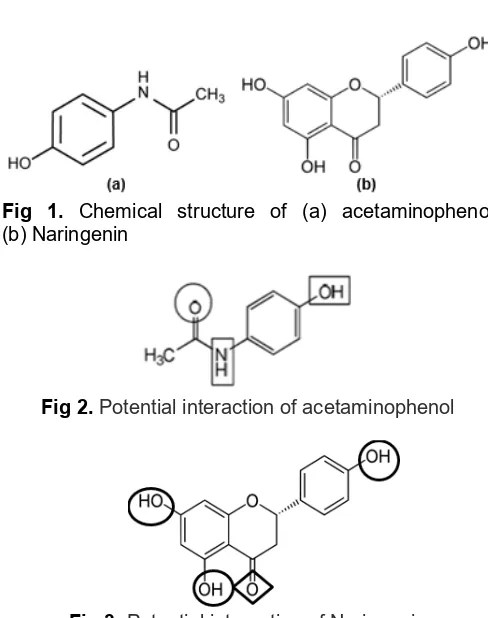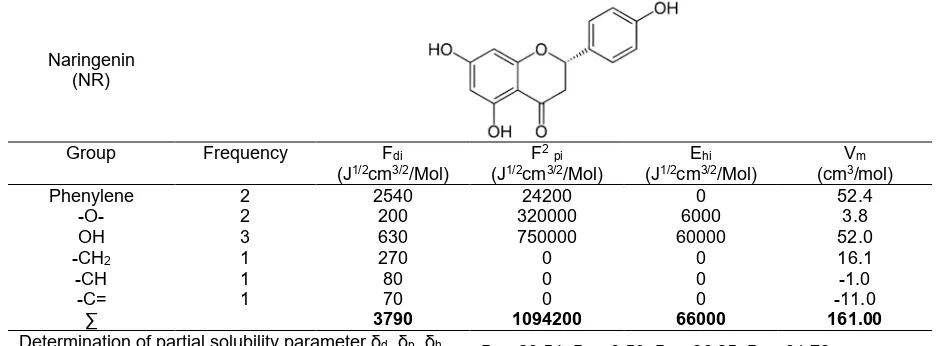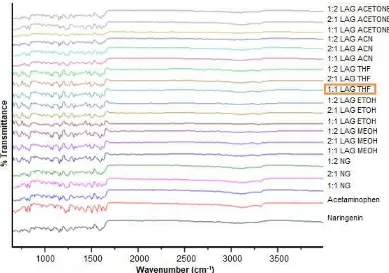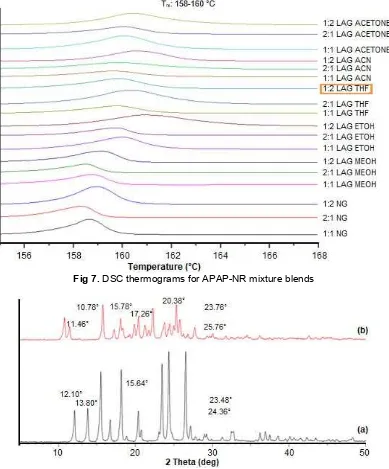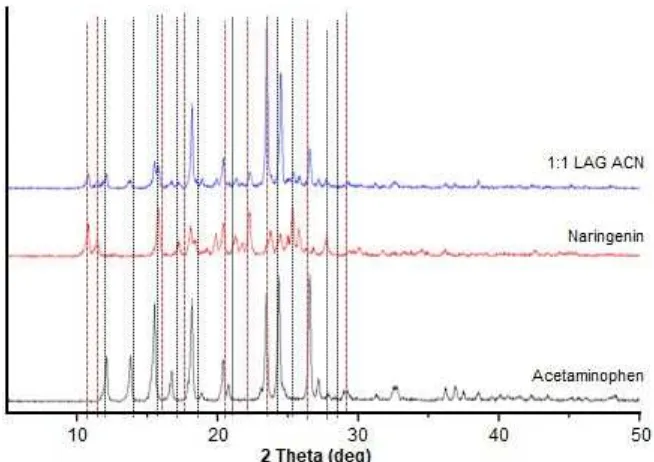Physical Mixture Interaction of Acetaminophenol with Naringenin
Normyzatul Akmal Abd Malek
1,2, Hamizah Mohd Zaki
1,2,*, and Mohammad Noor Jalil
1 1Faculty of Applied Sciences, Universiti Teknologi MARA, Shah Alam, 40000, Shah Alam, Selangor, Malaysia2Atta Ur Rahman Institute for Natural Product Discovery, Universiti Teknologi MARA, Puncak Alam, Bandar Puncak Alam, 42300, Selangor, Malaysia
Received July 18, 2017; Accepted January 3, 2018
ABSTRACT
The interaction of Active Pharmaceutical Ingredient (API) with other compounds will affect drugs stability, toxicity, modified dissolution profiles or may form a new compound with the different crystal structure. Acetaminophenol (APAP), the most common drug used widely (also known as Panadol) was mixed with Naringenin (NR) to glance for a new phase of interactions leading to new compound phase. The amide-acid supramolecular heterosynthon; N-H···O interaction between acid and the respective base were observed in the APAP-NR mixture blends. The interaction was prepared by the binary interaction from neat grinding and liquid-assisted grinding techniques at a different stoichiometry of binary mixture ratio of APAP-NR which were 1:1, 1:2 and 2:1 molar ratio. The interaction was estimated using Group Contribution Method (GCM) and physicochemical properties were characterized by Attenuated Total Reflectance Fourier Transform Infrared (ATR-FTIR), powder X-ray diffraction (PXRD) and Differential Scanning Calorimetry (DSC) analysis. The GCM calculation gave good interaction strength at 212.93 MPa1/2. The ATR-FTIR, DSC and PXRD results obtained revealed an interaction with new phase formed.
Keywords:neat grinding; acetaminophenol; Naringenin; intermolecular interaction
ABSTRAK
Interaksi Bahan Farmasi Aktif (API) dengan senyawa lain akan mempengaruhi stabilitas obat, toksisitas, mengubah profil disolusi atau dapat membentuk senyawa baru dengan struktur kristal yang berbeda. Asetaminofenol (APAP), obat yang paling umum digunakan secara luas (juga dikenal sebagai Panadol) dicampur dengan Naringenin (NR) untuk mengkaji pembentukan interaksi baru yang mengarah ke pembentukan fasa senyawa baru. Interaksi antara campuran APAP-NR dilihat melalui heterosinton supramolekuler amida-asam N-H···O antara asam dan basa yang sesuai. Interaksi ini disusun oleh interaksi biner dari teknik penggilingan kering dan penggilingan yang dibantu dengan cairan pada stoikiometri rasio biner campuran APAP-NR yang berbeda yaitu rasio molar 1:1, 1:2 dan 2:1. Interaksi diestimasi dengan menggunakan Metode Kontribusi Kelompok (GCM) dan sifat fisikokimia yang karakterisasi melalui Analisis Refleksi Total Fourier Transform Infrared (ATR-FTIR), analisis Difraksi sinar-X (PXRD) dan Diferensial Scanning Calorimetry (DSC). Perhitungan GCM memberikan kekuatan interaksi yang baik pada 212.93 MPa1/2. Hasil ATR-FTIR, DSC dan PXRD yang diperoleh menunjukkan adanya interaksi dengan fase baru yang terbentuk.
Kata Kunci: neat grinding; asetaminofenol; Naringenin; interaksi intermolekuler
INTRODUCTION
Pharmaceutical products are more commonly known as a fundamental component of both modern and traditional medicine. It is essential to study the interaction of Active Pharmaceutical Ingredients (API) with potential interaction compound present in Naringenin. The interaction may interfere with formulation stability and cause toxicity in the body system. The potentially harmful drug interaction and side effects can be reduced by understanding the route of interaction. Drug interactions can be categorized into
drug-drug interaction, drug-food/beverages interaction, and drug-conditions interactions.
[1-4]. Naringenin is also classified as one of pharmaceutically acceptable coformer in forming cocrystals with different drugs.
Preformulation of plants manufacture complex and numerous diverse compounds from the active pharmaceutical ingredients which work together will make a medicine is more than the sum of its active ingredients. In contrast, the application of pharmacological of herbs employs a dose that will induce strong drug-like effects in the human body system. In small doses, it stimulates the stomach, heart, and respiration; however, large doses might significantly affect the function of various mammalian cellular systems [5]. Therefore, the oral intake of common drugs such as APAP and any plants that consist of naringenin may lead to chemical interaction in the human body. The interaction might lead to the beneficial effect or toxicity to the human body. To date, there is no study which had been reported regarding the physicochemical interaction between APAP and Naringenin (NR) (Fig. 1). By establishing the precious data, it will assist and be a great aid for other nutrition scientists for further research and studies in investigating the effects of flavonoid pharmacodynamics effects with the active pharmaceutical ingredient, which leads to better understanding of the physicochemical interaction between APAP and NR.
As it is known, the biological activity and physicochemical properties of drugs are strongly dependent on their structure. The structural formulas and some physicochemical properties of these compounds have been studied and published for decades. The detailed investigations of intermolecular interaction have been anticipated by hydrogen bond. The chemical structure of APAP consists of several potential functional groups such as amide and hydroxyl (Fig. 2). Both of amide and hydroxyl groups APAP are considered as strong donors and acceptors of hydrogen bonding during interaction with NR. As described in the previous studies, the intermolecular interaction tends to interact through the hydrogen bond coming from the N-H···O and OH···O in acceptor groups [6-9].
According to review by Semalty [1], the NR chemical consists of two potential functional groups such as carbonyl and hydroxyl (Fig. 3). The NR is enriched with hydroxyl group that potent for interaction with a compound that has hydrogen bond donor or acceptor. Thus, the intermolecular interaction tends to interact more easily with the other compounds.
In the previous study, the physicochemical interaction of APAP with NR can be estimated by using empirical estimation method known as Group Contribution Method (GCM). The method was chosen due to the simplicity, universality and fast usage. It also represented empirical Quantity Structure-Property
Fig 1. Chemical structure of (a) acetaminophenol (b) Naringenin
Fig 2.Potential interaction of acetaminophenol
Fig 3.Potential interaction of Naringenin
Relationship (QSPR) approaches. The GCM relies on the availability of atom type, molecular group type or type of chemical bonding present to describe the structure giving the property contribution of each group.
EXPERIMENTAL SECTION
Materials
Acetaminophenol (APAP) and Naringenin (NR) were purchased from Sigma Aldrich. All the compounds were used as received. The solvent ethanol, methanol, tetrahydrofuran, acetonitrile, and acetone were purchased from the Fischer Scientific.
Instrumentation
All the pure NR and APAP and its binary mixture were characterized by Attenuated Total Reflectance Fourier Transform Infrared (ATR-FTIR), Powder X-ray Diffractometer (PXRD) and Differential Scanning Calorimetry (DSC).
Procedure
second was the preparation of binary mixture for PXRD followed with DSC and ATR-FTIR characterizations. The GCM method was adopted from a previous study [10].
The binary mixtures were obtained by solid dispersion techniques; neat grinding and liquid-assisted grinding. The preparation of solid dispersion techniques for 1:1 molar ratio, 1:2 molar ratio and 2:1 molar ratio by a binary mixture of APAP-NR were prepared by using a pestle and mortar.
RESULT AND DISCUSSION
In the present experiment, APAP-NR was prepared by two solid dispersion techniques; neat grinding (NG) and liquid-assisted grinding (LAG) with the different ratios of 1:1, 1:2 and 2:1. The physicochemical study provides information about feasible interactions between
APAP-NR mixtures. The physicochemical study was divided into two sections of study, which were, strength estimation of interaction of APAP-NR through GCM method and the data were supported and proven by ATR-FTIR, DSC and PXRD characterizations.
Hansen Solubility Parameter (HSP)
The miscibility of APAP and NR was accomplished via Hansen Solubility Parameter (HSP) calculation. The HSP value was calculated by combined Hoftyzer-Van Krevelen and Fedors group contribution method for drug and coformer. This method was generally done on the basis general approaches such as supramolecular synthons approaches. Table 1 represents the GCM calculation of APAP meanwhile Table 2 represent the GCM calculation
Table 1. Hansen solubility parameter calculation of Acetaminophenol by Hoftyzer-Van Krevelen and Fedors group contribution method
OH (at adjacent C
atom) 1 210 250000 20000 13.0
Phenylene 1 1270 12100 0 52.4
∑ 2230 466200 26100 101.7
Determination of partial solubility parameter δd, δp, δhand
total solubility parameter, δT δd = 21.93; δp = 6.71; δh = 16.02; δT= 27.97
Table 2. Hansen solubility parameter calculation of Naringenin by Hoftyzer-Van Krevelen and Fedors group contribution method
Naringenin (NR)
Group Frequency Fdi
(J1/2cm3/2/Mol)
Phenylene 2 2540 24200 0 52.4
-O- 2 200 320000 6000 3.8
OH 3 630 750000 60000 52.0
-CH2 1 270 0 0 16.1
-CH 1 80 0 0 -1.0
-C= 1 70 0 0 -11.0
∑ 3790 1094200 66000 161.00
Determination of partial solubility parameter δd, δp, δh
Fig 4.ATR-FTIR Spectra for pure APAP, NR, and its binary mixtures ratio of APAP-NR
of NR compound. The GCM calculation showed that the strength of interaction of APAP-NR was 212.93 MPa1/2. The value revealed that there was a high potential for interaction between APAP-NR might occurred during solid dispersion techniques. Thus, experimental data have been done for further interaction availability.
ATR-FTIR Study
In the present experiment, the APAP-NR complex was prepared by two simple solid dispersion methods. The formation of the complex was then confirmed by ATR-FTIR spectroscopy. ATR-FTIR spectra of the complex were compared with the spectrum of the individual starting materials and their mechanical mixtures. It was well known that acetaminophenol molecules consist of two hydrogen bond donor (N–H and O–H) groups and two hydrogen bond acceptor (C=O and H–O) groups. Acetaminophenol showed main characteristic ATR-FTIR peaks at 3319 cm-1 (-NH group), 3108 cm-1 (–OH group) and 1651 cm-1 (C=O group). These data have been compared and proved from previous studies [3,11-12]. ATR-FTIR analyses (Fig. 4) were used to confirm the functional group present in the spectra for APAP and NR pure samples before compared to the mixtures.
The ATR-FTIR spectra of mixtures (Fig. 5) showed the change in peaks in complexes and positions from pure compounds, thus, confirmed the existence of new
compound. The roles of hydrogen bonds in the binary mixture of APAP-NR were investigated by solid dispersion analysis. As an electron donor, the oxygen atom of OH of NR could provide electrons to APAP. It could be observed that the oxygen atom formed two hydrogen bonds each with APAP by the first and second lone pair electron respectively. This interaction demonstrated that OH at of NR has formed a favorable contribution to the inclusion forces, thus it has explained the reason why NR exhibited larger stability constant in the mixture. However, a large steric effect formed in the binary mixture might disturb the oxygen atom in forming the hydrogen bonds with the other atoms presented in APAP [13].
Fig 5.ATR-FTIR Spectra for pure APAP, NR, and its binary mixtures ratio of 1:2 LAG THF APAP-NR
Fig 6.DSC thermograms for Acetaminophenol and Naringenin
leading to a new formation of interaction in the binary mixture.
DSC Study
To substantiate the association of NR with APAP, DSC analysis was performed on the pure compound of NR, APAP, and APAP-NR mixtures. Fig. 6 and Fig. 7
Fig 7.DSC thermograms for APAP-NR mixture blends
Fig 8.Abundant PXRD diffraction patterns of pure component of (a) APAP and (b) NR
temperature. The onset temperature of blending mixture of APAP-NR appeared at a different temperature as compared to individual components provides evidence that original peak of APAP and NR were disappeared from the thermograms of blending mixtures in which it might be due to the change in intermolecular interaction during neat grinding and liquid-assisted grinding process. The interaction may be due to the new intermolecular interaction of hydrogen bonding. The –OH phenol rings of NR may be involved in hydrogen bonding with –NH amide group in APAP compound.
New melting temperature observed was classified as a eutectic point of the binary mixture of APAP-NR. This phenomenon suggested that there were interactions formed between solute molecules and solvent molecules in APAP-NR binary mixture. The 1:2 molar ratio of APAP-NR (LAG THF) has been selected due to the energy of newly formed bond was the
Fig 9.PXRD patterns for mixture blends of APAP, NR, and APAP-NR blend mixture at 1:1 LAG ACN
Powder X-Ray Diffraction Study
The percentages of crystallinity were identified by PXRD data analysis. The degree of crystallinity was defined as a percentage by weight of crystalline drug in a sample containing both amorphous and crystalline states. Thus, the degree of crystallinity was analyzed in studies of the effect on solid state stability [16]. Fig. 8 illustrates the unique characteristics in abundant PXRD patterns of individual components of APAP and NR at range 5-50°.
The PXRD patterns of NR shows at 2θ positions of
10.78°, 11.46°, 15.78°, 17.26°, 20.38°, 22.28°, 23.76°, 25.76° and 27.76°. Whilst diffraction peak of APAP were
listed at 2θ positions of 12.10°, 15.50°, 18.16°, 23.48°,
24.36° and 26.54°. These results were well supported by the previous studies [12,17-19]. APAP-NR cocrystal has unique crystalline diffraction patterns values of 18.18°, 18.90°, 20.42°, 22.34°, 23.50°, 23.54°, 24.46° and 24.54°. As illustrated in Fig. 9, the data shows 1:1 molar ratio of APAP-NR was majorly shifted from parent patterns. A different pattern of shifted peaks might be probably due to the polar and non-polar effect of solvent react with mixture blend thus affects the percentage of crystallinity [16]. It should be noted that solvent polarity plays an important role in affecting the reaction in solid dispersion technique.
The results showed that 1:1 LAG ACN has the sharper and higher intensities therefore, it can be concluded that the ratio has the highest feasibility of formation of binary mixture interaction of APAP-NR. The polarities of acetonitrile solvents used showed that has the relative ability to engage in strong interactions with
the mixture. PXRD diffraction of the 1:1 stoichiometric product proved that the APAP-NR has the feasibility for the binary mixture to form new intermolecular interaction.
CONCLUSION
The analysis and comparison of the ATR-FTIR spectra, DSC thermograms, and PXRD diffraction exhibited slight variations in the different varieties of interaction between acetaminophenol and flavonoids. These instrumentations provided useful information on a non-destructive analysis which allow them to be used as an alternative approach for quality control experiment in herbal materials. The results provided by the samples gave a new and rapid operational procedure as well as the characteristic data for the identification of chemical constituents in tested samples purposed. It should be noted that the type of anti-solvent plays important role in the reactions where it could affect the size and morphology of the particle during the process of mixing technique in solid dispersion. ATR-FTIR spectra, DSC thermogram and PXRD diffractogram data analysis verified that flavonoids compound mainly interacted with skeletal C– N–C group and C=O group of acetaminophenol to reinforce the intermolecular interaction in the mixture prepared.
ACKNOWLEDGEMENT
from Ministry of Higher Education of Malaysian Government; FRGS/2/2014/SKK03/UiTM/02/1 and Universiti Teknologi MARA, Malaysia (UiTM) for the research facilities.
REFERENCES
[1] Semalty, A., Semalty, M., Singh, D., and Rawat,
M.S.M., 2010, Preparation and characterization of phospholipid complexes of naringenin for effective
drug delivery, J. Inclusion Phenom.Macrocyclic
Chem., 67 (3-4), 253–260.
[2] Almalki, A.S.A., Naglah, A.M., Refat, M.S., Hegab, M.S., Adam, A.M.A., and Al-Omar, M.A., 2017, Liquid and solid-state study of antioxidant quercetin donor and TCNE acceptor interaction: Focusing on solvent effect on the morphological properties, J. Mol. Liq., 233, 292–302.
[3] Al-Zoubi, N., Koundourellis, J.E., and Malamataris, S., 2002, FT-IR and Raman spectroscopic methods for identification and quantitation of orthorhombic and monoclinic paracetamol in powder mixes, J. Pharm. Biomed. Anal., 29 (3), 459–467.
[4] Burgina, E.B., Baltakhinov, V.P., Boldyreva, E.V., and Shakhtschneider, T.P., 2004, IR spectra of paracetamol and phenancetin. 1. Theoretical and experimental studies,J. Struct. Chem., 45, 64–73. [5] Chua, L.S., Latiff, N.A., Lee, S.Y., Lee, C.T.,
Sarmidi, M.R., and Aziz, R.A., 2011, Flavonoids and phenolic acids fromLabisia pumila(Kacip Fatimah), Food Chem., 127 (3), 1186–1192.
[6] de Villiers, M.M., Wurster, D.E., Van der Watt, J.G., and Ketkar, A., 1998, X-Ray powder diffraction determination of the relative amount of crystalline acetaminophen in solid dispersions with polyvinylpyrrolidone,Int. J. Pharm., 163 (1-2), 219– 224.
[7] Felgines, C., Texier, O., Morand, C., Manach, C., Scalbert, A., Régerat, F., and Rémésy, C., 2000, Bioavailability of the flavanone naringenin and its glycosides in rats, Am. J. Physiol. Gastrointest. Liver Physiol., 279 (6), G1148–G1154.
[8] Hancock, B.C., York, P., and Rowe, R.C., 1997, The use of solubility parameters in pharmaceutical dosage form design,Int. J. Pharm., 148 (1), 1–21. [9] Hertog, M.G., Hollman, P.C., Katan, M.B., and
Kromhout D., 1993, Intake of potentially anticarcinogenic flavonoids and their determinants in adults in the Netherlands, Nutr. Cancer, 20 (1), 21–29.
[10] Hiendrawan, S., Veriansyah, B., Widjojokusumo, E., Soewandhi, S.N., Wikarsa, S., and Tjandrawinata, R.R., 2016, Physicochemical and mechanical
properties of paracetamol cocrystal with 5-nitroisophthalic acid, Int. J. Pharm., 497 (1-2), 106–113.
[11] Kachrimanis, K., Braun, D.E., and Griesser, U.J., 2007, Quantitative analysis of paracetamol polymorphs in powder mixtures by FT-Raman spectroscopy and PLS regression, J. Pharm. Biomed. Anal., 43 (2), 407–412.
[12] Kaialy, W., Larhrib, H., Chikwanha, B., Shojaee,
S., and Nokhodchi, A., 2014, An approach to
engineer paracetamol crystals by antisolvent crystallization technique in presence of various additives for direct compression, Int. J. Pharm., 464 (1-2), 53–64.
[13] Mohd Zaki, H., 2011, Spectroscopy Surface Analysis of Paracetamol and Paracetamol and Excipient Systems, Thesis, University of Manchester.
[14] Norhaiza, M., Maziah, M., and Hakiman, M., 2009, Antioxidative properties of leaf extracts of a popular Malaysian herb, Labisia pumila, J. Med. Plants Res., 3 (4), 217–223.
[15] Pathak, C.D., Savjani, K.T., Gajjar, A.K., and Savjani, J.K., 2013, Cocrystal formation of paracetamol with indomethacin and mefenamic acid: An efficient approach to enhance solubility, Int. J. Pharm. Pharm. Sci., 5 (4), 414–419.
[16] Pralhad, T., and Rajendrakumar, K., 2004, Study of freeze-dried quercetin–cyclodextrin binary systems by DSC, FT-IR, X-ray diffraction and SEM analysis, J. Pharm. Biomed. Anal., 34 (2), 333– 339.
[17] Middleton, E., 1994, “The Impact of Plant Flavonoids on Mammalian Biology: Implications for Immunity, Inflammation and Cancer” in The Flavonoids, Advances in Research since 1986, Harborne, J.B., eds., Chapman & Hall, London, U.K., 619–652.
[18] Wegiel, L.A., Mauer, L.J., Edgar, K.J., and Taylor, L.S., 2013, Crystallization of amorphous solid dispersions of resveratrol during preparation and storage—Impact of different polymers, J. Pharm. Sci., 102 (1), 171–184.
[19] Wen, J., Liu, B., Yuan, E., Ma, Y., and Zhu, Y., 2010, Preparation and physicochemical properties
of the complex of naringenin with
hydroxypropyl-β-cyclodextrin,Molecules, 15 (6), 4401–4407. [20] Xu, X.R., Yu, H.T., Hang, L., Shao, Y., Ding, S.H.,
and Yang, X.W., 2014, Preparation of
naringenin/β-cyclodextrin complex and its more
